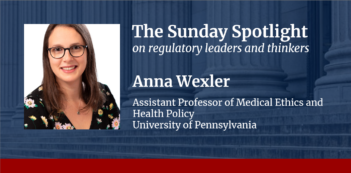
Now that Howard Shelanski is confirmed, he faces choices about his priorities.
Before leaving for its July 4 recess, the Senate voted to confirm Howard Shelanski as the new administrator of the Office of Information and Regulatory Affairs (OIRA), a post that had been vacant since last August.
Now that the Senate has confirmed Dr. Shelanski, what should he do for the next three years?
Legislators, advocacy groups, and scholars have put forward three main proposals for the new OIRA administrator to pursue.
The first proposal is to speed up the regulatory review process. OIRA is the principal clearinghouse for new rules issued by the executive branch. When a federal agency issues a proposed rule, it must first pass through the OIRA review process.
OIRA currently faces a growing pile of proposed rules awaiting approval, some of which have been in the queue for many months. These pending rules range from a major Food and Drug Administration (FDA) import safety rule to an Occupational Safety and Health Administration (OSHA) silica exposure rule.
Public health advocacy groups have criticized OIRA for stalling these and other rules. For example, the Coalition for Sensible Safeguards published a report in June claiming that seventy rules under review at OIRA had been held for longer than ninety days and some for over a year. Sidney Shapiro of the Center for Progressive Reform (CPR) issued a statement calling on Shelanski to “begin the critical task of reinvigorating our calcified regulatory system.”
However, other organizations value OIRA’s role in helping to prevent hastily formed regulations. Former Senator Blanche Lincoln (D-Ark), head of Small Businesses for Sensible Regulation, recently asked for “reassurance from Mr. Shelanski that he will not heed calls to speed up a regulatory process that too often fails to find the right balance.”
A second set of proposals call for OIRA to improve its transparency. According to CPR’s Shapiro, OIRA “frequently ignores its self-imposed obligation to identify the changes it or an agency makes” and “even actively discourages agencies from complying with these transparency requirements.”
A recent New York Times editorial advocated for increased transparency of OIRA’s role in rulemaking in order to help the “public to evaluate whether the White House’s involvement has improved or weakened the final rules.” Similarly, the Center for Effective Government has encouraged OIRA to start disclosing “details of private meetings in a timely manner” as well as “informing the public of the reasons for delaying a rule, and explaining any changes it makes to agency rules.”
A third proposal is to expand and improve retrospective review of existing federal rules, or what the Obama Administration calls regulatory “lookback.”
During President Obama’s first term, government agencies initiated hundreds of reviews of existing rules, but PPR’s Cary Coglianese recently wrote that these efforts only represent a “small step” toward what he believes needs to be done to institutionalize lookback as part of the regulatory process.
Coglianese has recommended that OIRA issue specific guidelines on how to conduct more scientific evaluations of existing regulations as well as that it require agencies to develop plans for future retrospective evaluation as part of agencies’ initial regulatory impact analyses. Doing so would encourage agencies to identify the type of data necessary to gauge the true impact of the nation’s regulatory state, he has argued.
Proponents of improving regulatory lookback may find some assurance from Shelanski’s vow during his confirmation hearing to build upon his predecessor’s efforts and enhance the evaluation of existing regulations.



